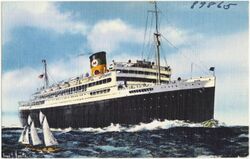Engineering:Turbo-electric transmission
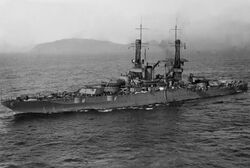
A turbo-electric transmission uses electric generators to convert the mechanical energy of a turbine (steam or gas) into electric energy and electric motors to convert it back into mechanical energy to power the driveshafts.
Turbo-electric drives are used in some rail locomotives (gas turbines, e.g. with the first TGV) and ships (steam and more recently gas turbines). An advantage of turbo-electric transmission is that it allows the adaptation of high-speed turbines to slow turning propellers or wheels without a heavy and complex gearbox. It has the advantage of being able to provide electricity for the ship or train's other electrical systems, such as lighting, computers, radar, and communications equipment. Other advantages for ships include greater watertight subdivision,[1][2] quieter operations, and safety (via instant thrust reversal by changing engine direct current polarity) for submarines.[3]
Ships with turbo-electric drive
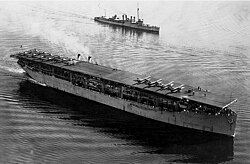

Warships
Battleships
Aircraft carriers
- USS Langley
- Lexington-class
- Queen Elizabeth-class (gas turbine)
Destroyer escorts
Destroyers
- Type 45 destroyers (gas turbine)
Troop ships
- Admiral W. S. Benson-class transports
- Gilliam-class attack transports
Submarines
- USS Glenard P. Lipscomb
- USS Tullibee
- Triomphant-class submarines
- Columbia-class submarines
- Dreadnought-class submarines
Auxiliary ships
- Suamico-class oilers
Coast Guard cutters
Merchant ships
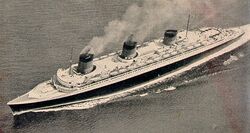


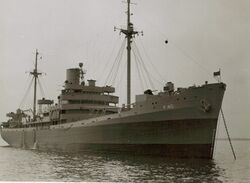
Ocean liners
- California (later Uruguay), Pennsylvania (later Argentina) and Virginia (later Brazil)
- Canberra – the most powerful steam turbo-electric units in a passenger ship, 42,500 shp (31,700 kW) per shaft, 2 shafts
- Monarch of Bermuda (later New Australia and Arkadia) and Queen of Bermuda
- RMS Mooltan (as re-engined in 1929)
- Morro Castle and Oriente (later USAT Thomas H. Barry)
- Normandie – most powerful steam turbo-electric passenger ship ever, 40,000 shp (30,000 kW) per shaft (50,000 shp at max power), 4 shafts
- Potsdam and Scharnhorst (later Japanese aircraft carrier Shinyo)
- President Cleveland and President Wilson (originally planned as Admiral W. S. Benson-class transports)
- President Hoover and President Coolidge
- RMS Queen Mary 2 – powered by General Electric gas turbines as well as her diesel generators to generate the current for her four Rolls-Royce electric podded azimuth thrusters
- Santa Clara (later USS Susan B. Anthony)
- Strath-class ocean liners RMS Strathnaver and RMS Strathaird
- Vaterland (1940)
- RMS Viceroy of India
Coastal liners
- Cuba (formerly Powhatan), converted to turbo-electric transmission in 1920
- Princess Marguerite (II) and Princess Patricia
Ferries
- TEV Wahine
- TEV Rangatira – possibly the World's last steam-powered turbo-electric merchant ship; scrapped 2005
- Union Rotorua and Union Rotoiti were both built as gas turbine ships with electric transmission. Rotoiti was subsequently re-engined to diesel.
Cruise ships
- Millennium-class cruise ships Celebrity Constellation, Celebrity Infinity, Celebrity Millennium and Celebrity Summit
Banana boats
- Darien (as re-engined in about 1930)
- Cargo and passenger liners (later Mizar-class stores ships) Antigua, USS Ariel, USS Merak, USS Mizar, USS Talamanca and USS Tarazed
- Musa and Platano
- San Benito, later USS Taurus
General cargo ships
- Arauca (later USS Saturn), Antilla and Orizaba
Bulk carriers
- Frank C. Ball was a lake freighter that was converted to turbo-electric propulsion in 1930.
- Carl D. Bradley
Oil tankers
See also
- Gas turbine-electric locomotive
- Steam turbine-electric locomotive
References
Notes
Sources
- Friedman, Norman (1984). U.S. Cruisers: An Illustrated Design History. Annapolis, MD: United States Naval Institute. ISBN 0-87021-739-9.
- Friedman, Norman (1985). U.S. Battleships: An Illustrated Design History. Annapolis, MD: United States Naval Institute. ISBN 0-87021-715-1.
- Friedman, Norman (1994). U.S. Submarines Since 1945: An Illustrated Design History. Annapolis, MD: United States Naval Institute. ISBN 1-55750-260-9.
External links
- Czarnecki, Joseph (31 January 2001). "Turboelectric drive in American Capital Ships". The Naval Technical Board. NavWeaps. http://www.navweaps.com/index_tech/tech-038.htm.
- Draper, John L (December 1930). "The Paddle Wheel to Electric Drive". Popular Mechanics: 898–902. https://books.google.com/books?id=qOIDAAAAMBAJ&q=Popular+Science+1930+plane+%22Popular+Mechanics%22&pg=PA898. — detailed article with drawing and charts on turbo-electric drive for ships and the advantages
